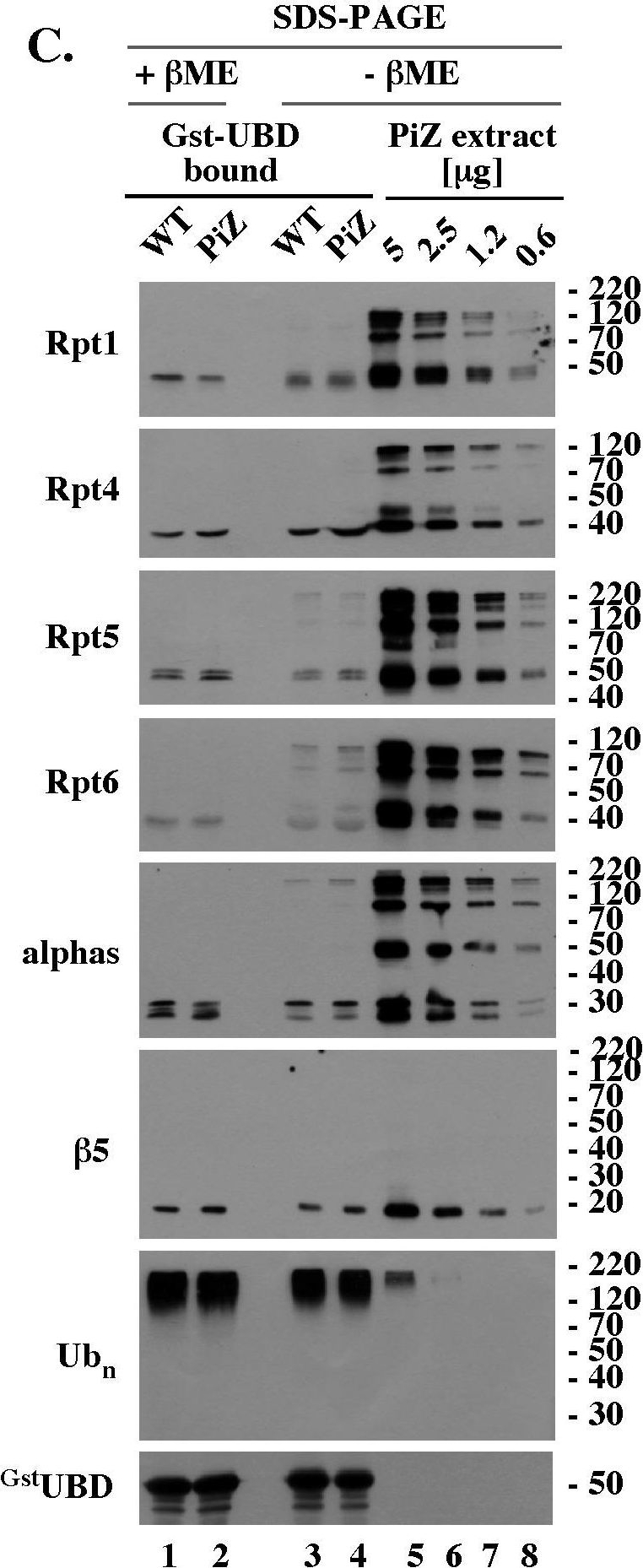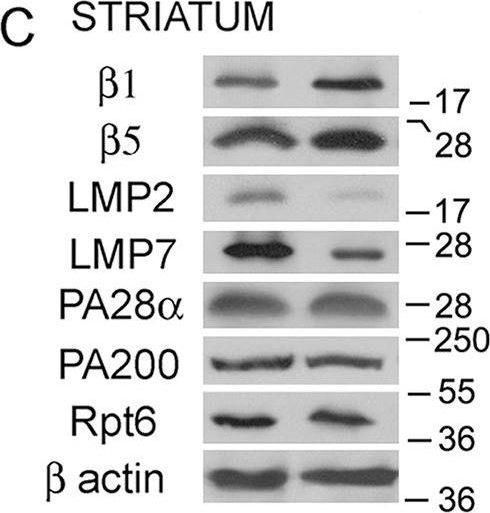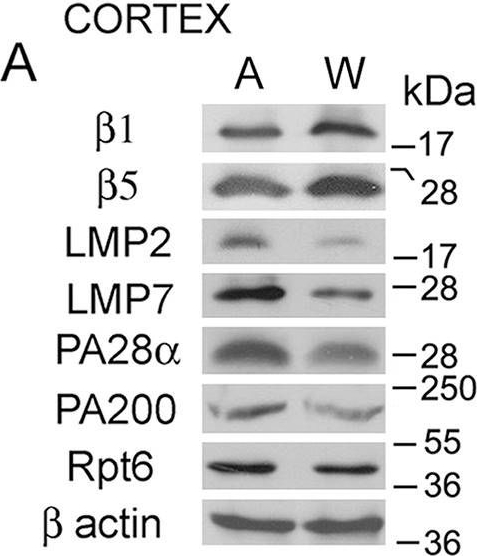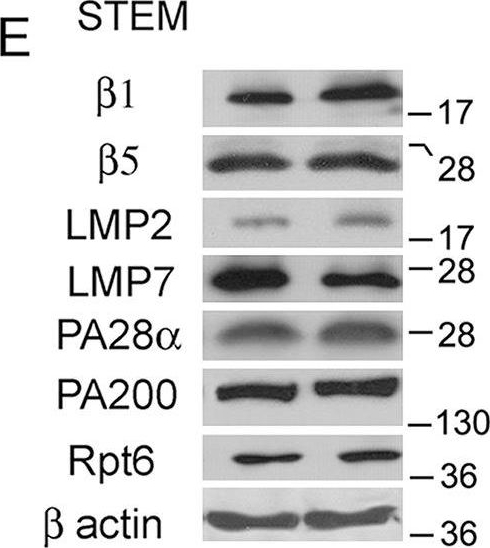The proteasome is widely recognised as the central enzyme of non-lysosomal protein degradation. It is responsible for intracellular protein turnover and it is also critically involved in many regulatory processes and, in higher eukaryotes, in antigen processing. The 26S proteasome is the key enzyme of the ubiquitin/ATP-dependent pathway of protein degradation. The catalytic core of this unusually large (2000kDa, 450Å in length) complex is formed by the 20S proteasome, a barrel shaped structure shown by electron microscopy to comprise of four rings each containing seven subunits. Based on sequence similarity, all fourteen 20S proteasomal subunit sequences may be classified into two groups, alpha and beta, each group having distinct structural and functional roles. The alpha-subunits comprise the outer rings and the beta-subunits the inner rings of the 20S proteasome. Observations of the eukaryotic proteasome and analysis of subunit sequences indicate that each ring contains seven different subunits (alpha7-beta7-beta7-alpha7) with a member of each sub-family represented in each particle. Each subunit is located in a unique position within the alpha- or beta-rings .
In addition to the 20S particle, the 26S complex contains over twenty additional proteins, ranging in molecular weight from 25 to 10kDa, located in a distinct complex called the ‘PA700 proteasome activator’ or the ‘19S complex’, and which determines substrate specificity and provides the multiple enzymatic functions necessary for proteolysis and viability. Systematic analysis of the sub-unit components have revealed at least six members to be ATPases belonging to a new family of ATPbinding proteins, together with a further fifteen sub-units that lack the capacity to bind ATP, isopeptidases and several other proteins thought to be responsible for the unfolding of a protein substrate prior to insertion into the proteolytic core of the 20S proteasome.
Shipping: Available products typically ship within 24/48h, via priority shipping.
Do you need support? Contact Customer Service or Technical Support.
Online Account
Access or Create Your Account
This antibody is covered by our Worry-Free Guarantee.

Western blot analysis of Proteasome 19S ATPase subunit Rpt6, mAb (p45-110) (Prod. No. BML-PW9265). Antibody dilution 1:1000 (lane a) and 1:5000 (lane b) using ECL procedure.

Reduction-sensitive modifications typical of aging WT mice accumulate prematurely on selected proteasomal subunits in the livers of PiZ mice.(A). Rpt4 Western blot analysis of unreduced, un-boiled liver extracts. 5 µg of the indicated extracts were mixed with Laemmli buffer without (unreduced samples) or with (reduced samples) βME (−/+ βME), separated by SDS-PAGE without prior boiling, and analyzed by Western blot with antibodies specific to Rpt4. (B). Rpt4 Western blot analysis of unreduced, but boiled, samples. Experiment like in A, lanes 1–9, except that extracts were mixed with Laemmli buffer without βME (- βME) and boiled for 4 minutes prior to SDS-PAGE. (C). Analysis of 26S proteasomes co-purified with polyubiquitin conjugates. WT and PiZ 26S proteasomes were co-purified with polyubiquitin conjugates as described in Fig. 4B and analyzed by Western blot after separation by SDS-PAGE with (lanes 1, 2) and without (lanes 3, 4) prior reduction by βME. Serial dilutions of unreduced liver extract from 103 old PiZ mouse are shown as reference (lanes 5–8). Extract prepared from 103 days old WT mice had similar reduction-sensitive modifications (data not shown, see panel A). (D). HPLC of WT and PiZ liver extracts followed by unreduced SDS-PAGE/Western blot analysis. Experiment like Fig. 5B, except that gel filtration fractions were not reduced with βME before SDS-PAGE. Data shown in A-D are representative of at least 3 independent experiments.
Image collected and cropped by CiteAb under a CC-BY license from the following publication: PiZ mouse liver accumulates polyubiquitin conjugates that associate with catalytically active 26S proteasomes. PLoS One (2014)

Expression of proteasome and activator subunits in brain parts of August and Wistar rats(A, C, E, G) Western blots of proteasome and activator subunits with the use of corresponding antibodies. Molecular mass of standard protein markers is shown. (B, D, F, H) The relative subunit quantities as percentage from the maximum magnitude normalized to β actin level and presented as means and SEM. *Reliable difference from control magnitude (p < 0.05, n = 8). A, August rats; W, Wistar rats.
Image collected and cropped by CiteAb under a CC-BY license from the following publication: Detection of active proteasome structures in brain extracts: proteasome features of August rat brain with violations in monoamine metabolism. Oncotarget (2017)

Expression of proteasome and activator subunits in brain parts of August and Wistar rats(A, C, E, G) Western blots of proteasome and activator subunits with the use of corresponding antibodies. Molecular mass of standard protein markers is shown. (B, D, F, H) The relative subunit quantities as percentage from the maximum magnitude normalized to β actin level and presented as means and SEM. *Reliable difference from control magnitude (p < 0.05, n = 8). A, August rats; W, Wistar rats.
Image collected and cropped by CiteAb under a CC-BY license from the following publication: Detection of active proteasome structures in brain extracts: proteasome features of August rat brain with violations in monoamine metabolism. Oncotarget (2017)

Expression of proteasome and activator subunits in brain parts of August and Wistar rats(A, C, E, G) Western blots of proteasome and activator subunits with the use of corresponding antibodies. Molecular mass of standard protein markers is shown. (B, D, F, H) The relative subunit quantities as percentage from the maximum magnitude normalized to β actin level and presented as means and SEM. *Reliable difference from control magnitude (p < 0.05, n = 8). A, August rats; W, Wistar rats.
Image collected and cropped by CiteAb under a CC-BY license from the following publication: Detection of active proteasome structures in brain extracts: proteasome features of August rat brain with violations in monoamine metabolism. Oncotarget (2017)





Product Details
| Alternative Name |
26S protease regulatory subunit 8, Proteasome 26S subunit ATPase 5, TRIP1, Thyroid hormone receptor-interacting protein 1, p45/SUG |
|---|---|
| Application |
IHC, IP, WB |
| Application Notes |
Detects a band of ~48kDa by Western blot. |
| Clone |
p45-110 |
| Formulation |
Liquid. In PBS, pH 7.4, containing 10mM sodium azide. |
| Host |
Mouse |
| Immunogen |
Recombinant human Rpt6 protein. |
| Isotype |
IgG2b |
| Purity Detail |
Partially purified. |
| Source |
Purified from hybridoma tissue culture supernatant. |
| Species Reactivity |
Human, Mouse, Rat |
| Specificity |
Recognizes the Rpt6/S subunit of the 19S regulator complex. |
| UniProt ID |
P62195 |
| Worry-free Guarantee |
This antibody is covered by our Worry-Free Guarantee. |
Handling & Storage
| Long Term Storage |
-20°C |
|---|---|
| Shipping |
Blue Ice |
| Regulatory Status |
RUO – Research Use Only |
|---|
- Inhibition of Proteasome LMP2 Activity Suppresses Chil3 Expression in Mouse Colon Adenocarcinoma Tissue and Restrains Tumor Growth.: Astakhova, T. M., Karpov, N. S., et al.; Oncol. Res. 33, 2573 (2025), Abstract
- Cypin regulates K63-linked polyubiquitination to shape synaptic content: Gandu, S., Rodriguez, A. R., et al.; Sci. Adv. 11, eads5467 (2025), Abstract
- Activation of the 20S proteasome core particle prevents cell death induced by oxygen- and glucose deprivation in cultured cortical neurons: Salazar, I. L., Curcio, M., et al.; Apoptosis 30, 1372 (2025), Abstract
- Association of Proteasome Activity and Pool Heterogeneity with Markers Determining the Molecular Subtypes of Breast Cancer.: Kondakova, I. V., Sereda, E. E., et al.; Cancers (Basel) 17, (2025), Reactant(s): Human, Abstract
- DDI2 protease controls embryonic development and inflammation via TCF11/NRF1: Nedomova, M., Haberecht-Müller, S., et al.; iScience 27, 110893 (2024), Abstract
- Activation of the 20S proteasome core particle prevents cell death induced by oxygen- and glucose deprivation in cultured cortical neurons: L. Salazar, I., Curcio, M., et al.; bioRxiv , (2024), Reactant(s): Rat
- Synaptic proteasome is inhibited in Alzheimer’s disease models and associates with memory impairment in mice.: Ribeiro, F. C., Cozachenco, D., et al.; Commun. Biol. 6, 1127 (2023), Application(s): ICC, WB / Reactant(s): Rat, Abstract
- Antioxidant Molecular Brain Changes Parallel Adaptive Cardiovascular Response to Forced Running in Mice.: Bartra, C., Jager, L. A., et al.; Antioxidants (Basel) 11, (2022), Application(s): WB / Reactant(s): Mouse, Abstract
- Resveratrol confers neuroprotection against high-fat diet in a mouse model of Alzheimer’s disease via modulation of proteolytic mechanisms: Sarroca, S., Gatius, A., et al.; J. Nutr. Biochem. 89, 108569 (2021), Abstract
- Proteasomes in Patient Rectal Cancer and Different Intestine Locations: Where Does Proteasome Pool Change?: Kulikov, A. M., Sharova, N. P., et al.; Cancers (Basel) 13, (2021), Reactant(s): Human, Abstract
- T-Type Ca2+ Enhancer SAK3 Activates CaMKII and Proteasome Activities in Lewy Body Dementia Mice Model.: Xu, J., Fukunaga, K., et al.; Int. J. Mol. Sci. 22, (2021), Application(s): WB / Reactant(s): Mouse, Abstract
- Fish Oil Diet during Pre‐mating, Gestation, and Lactation in Adult Offspring Rats on Cancer Cachexia Prevention: S.C.P. Oliveira, et al.; Mol. Nutr. Food Res. 65, e2000863 (2021), Abstract
- Proteasome Complexes and Their Heterogeneity in Colorectal, Breast and Pancreatic Cancers: Zagirova, D., Autenried, R., et al.; J. Cancer 12, 2472 (2021), Application(s): WB, Abstract
- Homeostatic scaling is driven by a translation-dependent degradation axis that recruits miRISC remodeling: Srinivasan, B., Samaddar, S., et al.; PLoS Biol. 19, e3001432 (2021), Abstract
- SAK3 Administration Improves Spine Abnormalities and Cognitive Deficits in AppNL-G-F/NL-G-F Knock-in Mice by Increasing Proteasome Activity through CaMKII/Rpt6 Signaling.: Fukunaga, K., Izumi, H., et al.; Int. J. Mol. Sci. 21, (2020), Application(s): WB / Reactant(s): Mouse, Abstract
- Altered phosphorylation of the proteasome subunit Rpt6 has minimal impact on synaptic plasticity and learning: Scudder, S. L., Gonzales, F. R., et al.; bioRxiv , (2019)
- Novel proteasome assembly chaperone mutations in PSMG2/PAC2 cause the autoinflammatory interferonopathy CANDLE/PRAAS4: de Jesus, A. A., Brehm, A., et al.; J. Allergy Clin. Immunol. 143, 1939 (2019), Abstract
- Exercise training prevents the perivascular adipose tissue-induced aortic dysfunction with metabolic syndrome: E. DeVallance, et al.; Redox Biol. 26, 101285 (2019), Abstract — Full Text
- ZFAND1 Recruits p97 and the 26S Proteasome to Promote the Clearance of Arsenite-Induced Stress Granules: Turakhiya, A., Meyer, S. R., et al.; Mol. Cell 70, 906 (2018), Abstract
- Combined Effect of Bortezomib and Menadione Sodium Bisulfite on Proteasomes of Tumor Cells: The Dramatic Decrease of Bortezomib Toxicity in a Preclinical Trial.: Akopov, S. B., Morozov, A. V., et al.; Cancers (Basel) 10, (2018), Application(s): WB, Abstract
- Inhibiting autophagy reduces retinal degeneration caused by protein misfolding.: Yao, J., Qiu, Y., et al.; Autophagy 14, 1226 (2018), Reactant(s): Mouse, Abstract
- Heterozygous Truncating Variants in POMP Escape Nonsense-Mediated Decay and Cause a Unique Immune Dysregulatory Syndrome.: Lupski, J. R., Gibbs, R. A., et al.; Am. J. Hum. Genet. 102, 1126 (2018), Application(s): WB / Reactant(s): Human, Abstract
- Proteasome phosphorylation regulates cocaine-induced sensitization: F.R. Gonzales, et al.; Mol. Cell. Neurosci. 88, 62 (2018), Reactant(s) Mouse, Abstract
- Cilostazol, a phosphodiesterase 3 inhibitor, activates proteasome-mediated proteolysis and attenuates tauopathy and cognitive decline: A.W. Schaler, et al.; Transl. Res. 193, 31 (2018), Abstract
- Reduction of RPT6/S8 (a Proteasome component) and proteasome activity in the cortex is associated with cognitive impairment in Lewy body dementia: A. Alghamdi, et al.; J. Alzheimers Dis. 57, 37 (2017), Abstract
- Detection of active proteasome structures in brain extracts: proteasome features of August rat brain with violations in monoamine metabolism: P.A. Erokhov, et al.; Oncotarget 8, 70695 (2017), Application(s): WB / Reactant(s) Rat, Abstract — Full Text
- Proteasome Activation by Small Molecules: Y. Leestemaker, et al.; Cell Chem. Biol. 24, 725 (2017), Application(s): SDS-PAGE / Reactant(s) Human, Abstract
- 6-bromo-indirubin-3′-oxime (6BIO), a Glycogen synthase kinase-3β inhibitor, activates cytoprotective cellular modules and suppresses cellular senescence-mediated biomolecular damage in human fibroblasts.: Trougakos, I. P., Papassideri, I., et al.; Sci. Rep. 7, 11713 (2017), Reactant(s): Human, Abstract
- Long-term leucine supplementation aggravates prolonged strenuous exercise-induced cardiovascular changes in trained rats: G.B. Dos Santos, et al.; Exp. Physiol. 101, 811 (2016), Abstract
- Inhibition of Proteasome Activity Induces Formation of Alternative Proteasome Complexes.: Eickelberg, O., Trümbach, D., et al.; J. Biol. Chem. 291, 13147 (2016), Application(s): Functional, WB / Reactant(s): Human, Abstract
- UBQLN2 Mediates Autophagy-Independent Protein Aggregate Clearance by the Proteasome: R. Hjerpe, et al.; Cell 166, 935 (2016), Application(s): Western blot, Abstract — Full Text
- Electron tomographic structure and protein composition of isolated rat cerebellar, hippocampal and cortical postsynaptic densities: M.M. Farley, et al.; Neuroscience 304, 286 (2015), Application(s): Immunogold labeling , Abstract
- Skeletal muscle myotubes in severe obesity exhibit altered ubiquitin-proteasome and autophagic/lysosomal proteolytic flux: L.M. Bollinger, et al.; Obesity (Silver Spring) 23, 1185 (2015), Application(s): Western Blot, Abstract — Full Text
- Protein phosphatase 2C-alpha knockdown reduces angiotensin II-mediated skeletal muscle wasting via restoration of mitochondrial recycling and function.: Yoshida, T., Sukhanov, S., et al.; Skelet. Muscle 4, 20 (2015), Application(s): WB / Reactant(s): Mouse, Abstract
- Ciliopathy proteins regulate paracrine signaling by modulating proteasomal degradation of mediators: Liu, Y. P., Tsai, I. C., et al.; J. Clin. Invest. 124, 2059 (2014), Abstract
- PiZ mouse liver accumulates polyubiquitin conjugates that associate with catalytically active 26S proteasomes.: Blomenkamp, K., Teckman, J., et al.; PLoS One 9, e106371 (2014), Application(s): WB, Abstract
- Nucleus Accumbens 1, a Pox virus and Zinc finger/Bric-a-brac Tramtrack Broad protein binds to TAR DNA-binding protein 43 and has a potential role in Amyotrophic Lateral Sclerosis.: Scofield, M. D., Korutla, L., et al.; Neuroscience 227, 44 (2012), Application(s): ICC / Reactant(s): Mouse, Abstract
- Dynamics of the degradation of ubiquitinated proteins by proteasomes and autophagy: association with sequestosome 1/p62: N. Myeku, et al.; J. Biol. Chem. 286, 22426 (2011), Application(s): Western blot, Abstract — Full Text
- BAG-6 is essential for selective elimination of defective proteasomal substrates: Minami, R., Hayakawa, A., et al.; J. Cell Biol. 190, 637 (2010), Abstract
Last modified: May 29, 2024
Datasheet, Manuals, SDS & CofA
Manuals And Inserts
Certificate of Analysis
Please enter the lot number as featured on the product label
SDS
Enzo Life Science provides GHS Compliant SDS
If your language is not available please fill out the SDS request form
 Lab Essentials
Lab Essentials AMPIVIEW® RNA probes
AMPIVIEW® RNA probes Enabling Your Projects
Enabling Your Projects  GMP Services
GMP Services Bulk Solutions
Bulk Solutions Research Travel Grant
Research Travel Grant Have You Published Using an Enzo Product?
Have You Published Using an Enzo Product?
